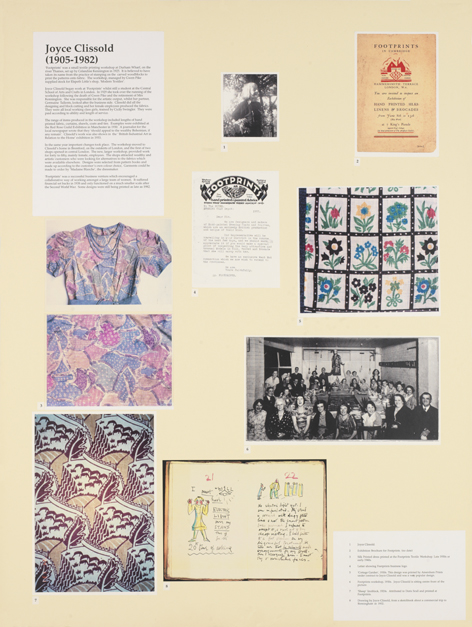
'Footprints' was a small textile printing workshop at Durham Wharf, on the river Thames, se up by Celandine Kennington in 1925. Its believed to have take its name from the practice of stamping on the carved woodblocks to print the patterns onto fabric. The workshop, managed by Gwen Pike supplied stock for Elspeth Little's shop, 'Modern Textiles'.
Joyce Clissold began work at 'Footprints' whilst still a student at the Central School of Arts and Crafts in London. In 1929 she took over the running of the workshop following the death of Gwen Pike and the retirement of Mrs Kennington. She was responsible for the artistic output, whilst her partner, Germaine Tallents, looked after the business side. Clissold did all the designing and block cutting and her female emplyees produced the fabrics. They were all local working class girls, trained by Cicily Swingler. They were paid according ro ability and length of service.
The range of items prodiced in the workshop included lengths of hand printed fabric, curtains, shawls, coats and ties. Examples were exhibited at the Red Rose Guild Exhibition in Manchester in 1930. A journalist for the local newspaper wrote that they 'should appeal to the wealthy Bohemian, if any remain'. Clissold's work was also shown in the 'British Industrial Art in Relation to the Home' exhibition in 1933.
In the same year important changes took place. The workshop moved to Clissold's home in Brentford, on the outskirts of London, and the first of two shops opened in central London. The new, larger workshop, provided work for forty to fifty, mainly female, employees. The shops attracted wealthy and artistic customers who were looking for alternatives to the fabrics which were available elsewhere. Designs were selected from pattern books and made up according to the customer's own colour choice. Garments could be made to order by 'Madame Blanche', the dressmaker.
'Footprints' was a successful business venture which encouraged a collaborative way of working amongst a large team of women. It suffered financial set backs in 1938 and only functioned on a much smaller scale after the Second World War. Some designers were still being printed as late as 1982.
Image captions clockwise from the top
1. Joyce Clissold.
2. Exhibition brochure for Footprints (no date).
3. 'Cottage Garden', 1930s. This design was printed by Amersham Prints under contract to Joyce Clissold and was a very popular design.
4. Footprints workshop, 1930s. Joyce Clissold is sitting centre front of the picture.
5. Drawing by Joyce Clissold, from a sketchbook about a commercial trip to Birmingham in 1932.
6. 'Sheep' linoblock, 1920s. Attributed to Doris Scull and printed at Footprints.
7. Silk printed dress printed at the Footprints Textile Workshop. Late 1930s or early 1940s (two images).
8. Letter showing Footprints business logo.